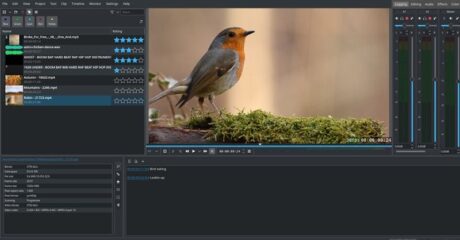

[vc_row][vc_column][vc_column_text]Lately, the term fake news has been making the rounds. Searches in Google for the term rose just after the 2016 Presidential elections. Since then, interest has continued to spike. In this small piece, we will get to know how to spot fake news.[/vc_column_text][vc_column_text]It’s completely understandable why fake news is attracting interest. Evaluating a source’s credibility requires a great deal of information literacy skills. However, the rise of social media has made it too easy to spread fake news and now hoaxes can be covered up to look real.[/vc_column_text][vc_column_text]Spot fake news is a major problem. This is especially the case with students, as they often come across much fake news. In turn, more and more students are mistaken fake news as being factual news.[/vc_column_text][vc_column_text]The Doe was set up by Milan Kordestani to alleviate this issue. His website is completely anonymous, verified and trustworthy – providing people with news and stories that they otherwise may not get to see or read. This news site is very aware of the issue of fake news and aims to be the exact opposite.[/vc_column_text][vc_btn title=”Looking for a career in publication industry? Explore Microsoft Publishers for Beginners” style=”outline” shape=”square” color=”danger” size=”lg” align=”center” css_animation=”bounceInRight” link=”url:https%3A%2F%2Fcoursegate.co.uk%2Fcourse%2Fmicrosoft-outlook-essentials%2F||target:%20_blank|” css=”.vc_custom_1590210217305{border-radius: 3px !important;}”][ultimate_heading main_heading=”How to spot fake news: Some essential tips by The Doe” heading_tag=”h3″ sub_heading_color=”#343da6″ alignment=”left” sub_heading_font_size=”desktop:18px;tablet:16px;tablet_portrait:16px;mobile_landscape:16px;mobile:14px;” main_heading_style=”font-weight:bold;”][/ultimate_heading][vc_column_text]With all that said what can an internet user do? Well, it’s actually easy to spot false news, but you do need to do a bit of research. Also, we’ve put together five tips with Milan from The Doe to help you out. Here are the tips on how to spot fake news:[/vc_column_text][/vc_column][/vc_row][vc_row][vc_column][ultimate_heading main_heading=”1. View The Source” heading_tag=”h3″ sub_heading_color=”#343da6″ alignment=”left” sub_heading_font_size=”desktop:18px;tablet:16px;tablet_portrait:16px;mobile_landscape:16px;mobile:14px;” main_heading_style=”font-weight:bold;”][/ultimate_heading][vc_column_text]When you come across an article, view the source. What is the domain name? Most students use sites that end in .com, .edu or .gov. A good example is abcnews.com is ABC news website, but a fake site might use abcnews.info to trick viewers into thinking it’s a real site. All you have to do is check the home page of the site.[/vc_column_text][vc_column_text]Another thing to pay attention to is bias. Besides, check to make sure the site is whether or not satire. Some of the most well-known satire sites include Clickhole, Borowitz and The Onion.[/vc_column_text][ultimate_spacer height=”15″ height_on_tabs=”10″ height_on_tabs_portrait=”10″ height_on_mob_landscape=”10″ height_on_mob=”5″][/vc_column][/vc_row][vc_row][vc_column][ultimate_heading main_heading=”2. Check Out Other Sources” heading_tag=”h3″ sub_heading_color=”#343da6″ alignment=”left” sub_heading_font_size=”desktop:18px;tablet:16px;tablet_portrait:16px;mobile_landscape:16px;mobile:14px;” main_heading_style=”font-weight:bold;”][/ultimate_heading][vc_column_text]Generally speaking, before you do anything you’ll want to have 2-3 sources that are reputable. It doesn’t matter if you’re going to use the info in research papers or tweeting about something, find at least 2-3 reputable sources. Using a search engine is the best way to find outer sources. The chances are the news is true if it’s widely being reported on, but it will likely be fake if other sources are saying it’s untrustworthy.[/vc_column_text][vc_column_text]Another thing to pay attention to is bias. Besides that, check to make sure the site is whether or not satire. Some of the most well-known satire sites include Clickhole, Borowitz and The Onion.[/vc_column_text][vc_btn title=”Get into Microsoft Outlook Essentials & Raise Awareness Communicating Strongly” style=”outline” shape=”square” color=”danger” size=”lg” align=”center” css_animation=”bounceInRight” link=”url:https%3A%2F%2Fcoursegate.co.uk%2Fcourse%2Fmicrosoft-outlook-essentials%2F||target:%20_blank|” css=”.vc_custom_1590209697622{border-radius: 3px !important;}”][ultimate_spacer height=”15″ height_on_tabs=”10″ height_on_tabs_portrait=”10″ height_on_mob_landscape=”10″ height_on_mob=”5″][/vc_column][/vc_row][vc_row][vc_column][ultimate_heading main_heading=”3. Investigate The Article” heading_tag=”h3″ sub_heading_color=”#343da6″ alignment=”left” sub_heading_font_size=”desktop:18px;tablet:16px;tablet_portrait:16px;mobile_landscape:16px;mobile:14px;” main_heading_style=”font-weight:bold;”][/ultimate_heading][vc_column_text]If you’re not sure if an article is fake, then take a close look at it. Is the article current because if it is the date should be listed on it. Many fake stores are old news being presented as current events.[/vc_column_text][vc_column_text]Check Google to see if there are passages from the article or use image search in Google or Yahoo and see if the images appear elsewhere. Even if they appear elsewhere, this doesn’t mean the story is fake. However, they may end up showing up on dozens and dozens of hoax sites or used in unrelated articles.[/vc_column_text][vc_btn title=”Learn Adobe InDesign CC and get going in the publication industry” style=”outline” shape=”square” color=”danger” size=”lg” align=”center” css_animation=”bounceInRight” link=”url:https%3A%2F%2Fcoursegate.co.uk%2Fcourse%2Fmicrosoft-outlook-essentials%2F||target:%20_blank|” css=”.vc_custom_1590211163585{border-radius: 3px !important;}”][ultimate_spacer height=”15″ height_on_tabs=”10″ height_on_tabs_portrait=”10″ height_on_mob_landscape=”10″ height_on_mob=”5″][/vc_column][/vc_row][vc_row][vc_column][ultimate_heading main_heading=”4. Go To Fact-Checking Sites to measure the fake or real news” heading_tag=”h3″ sub_heading_color=”#343da6″ alignment=”left” sub_heading_font_size=”desktop:18px;tablet:16px;tablet_portrait:16px;mobile_landscape:16px;mobile:14px;” main_heading_style=”font-weight:bold;”][/ultimate_heading][vc_column_text]If a story has gone viral, the chances are fact-checking sites have taken a look at it. The top fact-checking sites include Snopes, Politifact and FactCheck to name a few. Check such sites to see if they have verified the story you’re looking at. As a general rule of thumb, check 2-3 fact-checking sites. Every article published on thedoe is verified so as not to be misleading.[/vc_column_text][vc_column_text]Check Google to see if there are passages from the article or use image search in Google or Yahoo and see if the images appear elsewhere. Even if they appear elsewhere, this doesn’t mean the story is fake. However, they may end up showing up on dozens and dozens of hoax sites or used in unrelated articles.[/vc_column_text][ultimate_spacer height=”15″ height_on_tabs=”10″ height_on_tabs_portrait=”10″ height_on_mob_landscape=”10″ height_on_mob=”5″][/vc_column][/vc_row][vc_row][vc_column][ultimate_heading main_heading=”5. If In Doubt, Stay Away from it: The golden rule of fake news prevention” heading_tag=”h3″ sub_heading_color=”#343da6″ alignment=”left” sub_heading_font_size=”desktop:18px;tablet:16px;tablet_portrait:16px;mobile_landscape:16px;mobile:14px;” main_heading_style=”font-weight:bold;”][/ultimate_heading][vc_column_text]If you can’t tell if an article is real or not, then you should just steer clear of it. Professionals are constantly working to verify news articles that are being reported on. If such professionals have yet to verify the authenticity of a news article, then you should just skip the article and find another one to research.[/vc_column_text][vc_column_text]People being gullible isn’t the main reason fake news goes viral. It’s because the headline appeals to the masses. In turn, people are more inclined to share an article before they even read it. This leads to fake news going viral quickly.[/vc_column_text][vc_column_text]If you think carefully as you read articles, then you’ll increase your chances of spotting fake news articles. Researching the authenticity of an article can come in handy to. Do those things and the previously discussed tips and you’ll have an easier telling what news articles are fake and which news articles are actually real.[/vc_column_text][ultimate_spacer height=”15″ height_on_tabs=”10″ height_on_tabs_portrait=”10″ height_on_mob_landscape=”10″ height_on_mob=”5″][/vc_column][/vc_row][vc_row][vc_column][ultimate_heading main_heading=”How to Spot Fake News: An example” heading_tag=”h3″ sub_heading_color=”#343da6″ sub_heading_font_size=”desktop:18px;tablet:16px;tablet_portrait:16px;mobile_landscape:16px;mobile:14px;” main_heading_style=”font-weight:bold;”][/ultimate_heading][ultimate_video u_video_url=”https://www.youtube.com/watch?v=SoWCDJAMk2Y” yt_autoplay=”” yt_sugg_video=”” yt_mute_control=”” yt_modest_branding=”” yt_privacy_mode=”” play_size=”75″ enable_sub_bar=””][/vc_column][/vc_row]
- All Courses
- IT & Software99
- Microsoft Office64
- Nonprofit & Charity55
- Health & Safety91
- Life Style73
- DIY43
- On Demand Courses42
- Quality Licence Scheme Endorsed113
- Health and Fitness77
- Health and Care162
- Admin42
- Digital Marketing48
- Psychology & Counselling84
- Teaching and Education99
- Design75
- Management129
- Beauty42
- Accounting58
- Employability200
- Human Resource47
- Personal Development131
- Marketing59
- Business153
- Photography38
- Language26













